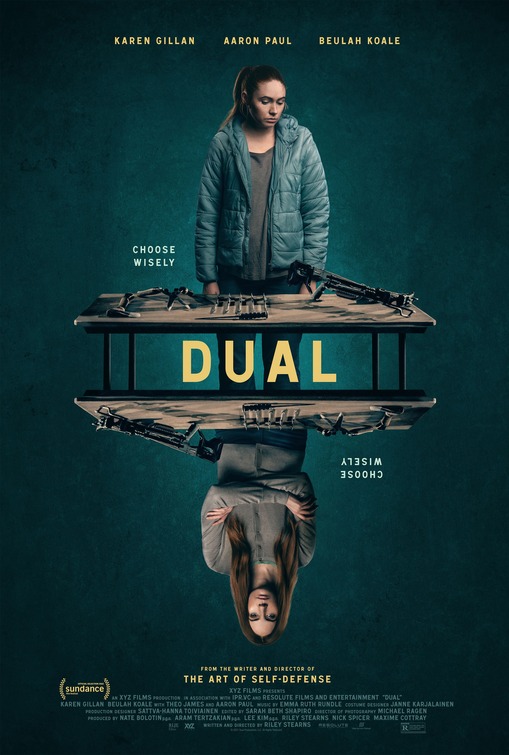There’s a very specific phenomenon that occurs when watching recently made films that don’t have many similar counterparts in the modern age. It’s hard not to factor in the global pandemic when watching anything produced since 2019. Obviously there have been many major historic events that create demarcation in how a movie would’ve been received prior or post such an occasion. But COVID-19 is unique in how literally global it is, occurring roughly at the same times across nations, and affecting all levels of society directly or indirectly. From a technical perspective, that may have meant new scheduling, reshoots, or rearranging stories to adhere to COVID safety protocols and utilize the diminished number of resources (locations, cast members, and more) now available. But films made in the time of the pandemic also give pause to viewers wondering when it was written; is this story one borne out of a worldwide catastrophe with its traumatic repercussions constantly resounding to ever further parts of society? Is it a commentary on the isolation many experienced? This even can reach literally visual elements where characters may be gathered in groups on screen or not wearing masks and now audiences are wondering if it takes place in a world without the pandemic? Does it take place in some future time and place where COVID-19 is in the rear view? It’s possible many people aren’t actively processing this when watching movies made from 2019 to now, but at least some of these questions are being asked quietly in the backs of everyone’s minds as they watch the new release.

Writer/director Riley Stearns announced DUAL in April 2020 with photography taking place in October 2020 (in Finland). While the project was clearly gestating for a while before its announcement, so it wasn’t originally written in response to the worsening situation in the world, it’s possible that aspects of it were tweaked or reshaped in the shadow of everyone’s experiences in the completely unprecedented historical event. Even if Stearns’ film wasn’t revised in some manner over the early height of the pandemic, there are a lot of elements that touch on common psychological experiences of COVID-19: isolation, the lingering but ill-defined threat of death over months, attempting to reinvent oneself in the liminal space of seemingly indefinite lockdown, and being consumed by bleak depression but still actively surviving for reasons that are unclear at best. Or maybe the pandemic simply drew bold underlines under these issues that have been around for centuries, making them more pressing topics that more people must confront somehow.
In the not-too-distant future (possibly), Sarah (Karen Gillan) is diagnosed with a rare, fairly vague but absolutely terminal, illness. In this world, a process called “Replacement” exists that creates clones of the soon-to-be-deceased person so that the friends and families of the dead don’t have to suffer any sadness from losing this person they care about. It’s ridiculously expensive, but ultimately that will be the clone’s responsibility as the original enlistee is no longer in the land of the living. Sarah opts for this and receives a Sarah Double, who will shadow the dying original to copy the personality as much as possible and ease the transition for Sarah’s boyfriend Peter (Beaulah Koale) and her mother (Maija Paunio). When Sarah stops being terminally ill, after many months and constant guarantees death was imminent, Sarah Double must be destroyed as there can’t be two of the same person out there. Unfortunately, Peter and Sarah’s mother prefer Sarah Double to the classic version, and now the two Sarahs must duel to the death (eh? Double meaning in the title!). Sarah seeks out the help of a combat trainer (Aaron Paul) as she prepares to decimate the doppelgänger who stole her life.
DUAL is a darkly hilarious film that does excellent world-building in the background while creating a vital and engaging central narrative around a few characters. Based on his previous two films, FAULTS and THE ART OF SELF-DEFENSE, it appears Stearns’ style is to tackle real emotions and issues via heavily artificial ways of interacting. People speak to each other in weird ways that seem to divulge too much information but also communicate nothing of the actual interior life of each other. Ridiculous elements are taken in stride, often in a monotonal exchange reserved for questions and answer sections of corporate PowerPoints. All the characters are blatantly broken in fundamental ways, yet there are clear indications that this is the known state of things and so folks must carry on.
Based on the past two paragraphs, you can see the origins of wondering about the influence of the pandemic on DUAL.
But the film also brought into sharp relief two elements previously missed in Stearns’ work (being those two features that I loved). One is that he and Yorgos Lanthimos (THE LOBSTER, THE KILLING OF A SACRED DEER) are very similar in the worlds their storytelling, albeit through obvious individual differences in approach and outlook. Both filmmakers create worlds of accepted weird practices populated by blunt discussions that carry uncomfortable frankness but also belie a cold distance between people. The characters speak like they were born from an instructional manual on oversharing for androids, but there are wells of emotion hidden beneath their deadpan conversations. There is also a streak of mordant comedy in the absurd juxtaposition of the events and how people react, their taciturn expressions creating awkward hilarity. Lanthimos seems a bit more misanthropic in his films while Stearns still imbues his stilted stories with some degree of hope.
The other element that became pronounced in Stearns’ work is how much it feels like the stories of Nikolai Gogol told through modern lenses. The Russian absurdist/fantasist/social gadfly used heightened events to examine the inherent silliness of social conventions and people’s reactions to them; like a nose becoming sentient, leaving the face on which it sat, becoming more popular than its previous host, before awkwardly return to the person in humiliated defeat. The technology in DUAL is at once futuristic (full age cloning and all that), modern (similar devices, teleconferencing, and porn websites), and antiquated (fonts and videos belonging to the late ‘80s designs of advertising and UI). It’s a clever way of making this world exist at every time, and therefore comment on all those times, but not in an ill-defined way that feels like a crutch for plot contrivances.
DUAL shines brightest thanks to Stearns’ writing and the amazing performance of Gillan. All the characters are reticent to display emotion, choosing instead to hide it in overly formal dialogue. Yet there is no mistaking the barely restrained rage and suffocating sadness that lies just beneath Sarah’s appearance. And this work is made even more impressive by the subtle shades used for Sarah’s Double, where it’s very much similar mannerisms and cadences but done with just enough of minor changes that they are clearly distinct people. The cruel egotism of Peter and Sarah’s mother still hits hard no matter how matter-of-factly it is demonstrated, or how awkwardly comedic it plays out. There are moments that go from being wryly funny to infuriating due to everyone’s indifference to this person who has lived under the Sword of Damocles for well over a year.
The idea of reinvention, literally through making a new version of oneself via cloning or creating a new approach to life out of horrible circumstances, permeates DUAL. Paul is a well-known archetype of overly seriousness yet patently ill-equipped. It’s like if Max Fischer in RUSHMORE or Sensei in THE ART OF SELF-DEFENSE, matched with the childlike understanding of the world like a character from I Think You Should Leave. He and Gillan have good chemistry (or perhaps anti-chemistry in the emotionally detached world of DUAL) and their training montages are comically inventive. The ‘instructional’ DVDs that Paul lends Gillan are basically low-budget horror movies that seem like they serve no purpose but are incredibly fun to watch with their excessive gore and insanity.
The biggest detriment to DUAL is its ending. It’s not bad, per se, but at one point it becomes very telegraphed, forcing viewers to wait to get to the fireworks factory before the credits roll. And perhaps that clear path forward is part of what makes it feel very anticlimactic; yes, it makes sense from a construction and storytelling perspective, but the lack of surprise in execution feels like an unfortunate shrug. This is probably intentional given pedigrees of works like Lanthimos and Gogol that basically use a specific slice to indict an entire people, meaning that whatever happened or changed in this particular case doesn’t ultimately change a whole world populated by such limited emotional language.
Stearns’ film is more of the smirk and think “that’s clever” style of dark comedy than one filled with guffaws or even shock. There are a few genuine laugh-out-loud moments that come from Gillan’s delivery, or the bizarre dialogue written for these weird interactions. There’s not much shocking in the movie, though it’s surprising how frustrating it is to watch the toxic people in Sarah’s life embrace Sarah’s Double over the woman they’ve known all their lives. DUAL is a flawed copy of what came before, but it manages to be its own entity even with that familiar DNA swimming in its storytelling. It may not have been shaped by the pandemic, but its themes resonate even more in light of these ubiquitous feelings that have risen in so many people over the past two years.
Tags: Aaron Paul, Beaulah Koale, Emma Ruth Rundle, Karen Gillan, Maija Paunio, Riley Stearns, RLJE Films, Sarah Beth Shapiro, satire, Sci-Fi, Theo James, Thriller, XYZ Films



No Comments